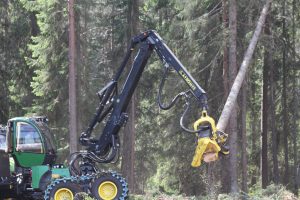Now the time has come for the big harvest – the final felling. If the pre-commercial and commercial thinning’s has been properly done, now is the time to collect the big profit.
Final felling
I once met two guys who were dealing with Swedish timber in their respective home countries that were Iran and Iraq. They had both been living in Sweden for some years. They told me that they were totally fascinated by, as they called it, the Swedish way of thinking – that what you invest today gives payback after 80 years. As you may have guessed, it was Swedish forestry they referred to.
As we know, forestry in the northern hemisphere is a project that runs over generations. If you are the planter you are not likely to be the one who gets the profit of that investment in the end.
Photo: Per Jonsson
Payback time
As much as 80 – 90 % of the profit from the forest comes at the final felling. In the meantime, the final felling is both the end of a forest generation and the beginning of a new one. Already before you start cutting, the reforestation should be included in the plan. If you intend to use natural regeneration, which is suitable for Scots Pine (Pinus Silvestris), you have to know how many seed trees that should be left. If you intend to plant or seed, you have to decide about species. That part is quite easy in Sweden as we more or less only use Scots Pine and Norwegian Spruce (Picea Abies).
Choose the stand
First of all, the clear-cut stand must have reached the allowed minimum age for final felling according to the Forestry Act. The minimum age is dependent on the site quality, geographical location and species.
If you have a lot of old enough forest to choose from, it´s important that you take it in the right order. If you have old stands of both pine and spruce, spruce would be the best to start with as old spruce trees tend to rot. Pine, on the other hand, could stand up against rot also when it´s older.
Damaged and good quality stands
Stands that have been thinned out by windthrow, or for other reasons, and doesn´t hold the optimal volume and growth rate for the site, should also be prioritized for felling.
If a stand contains trees of very good quality, it has good value growth and could, if possible, be saved some years before cutting it. This goes mainly for pine forests as they are more resistant to rot, as mentioned above, and can actually keep growing a while longer.
Certified forests must have a forest management plan. Most forest owners have one, and here all these issues are stated. If the plan is up to date the task of choosing stand will be quite easy.
Nature conservation and certification
14,9 million hectares (63 %) of the Swedish productive forest land is certified according to either FSC (Forest Stewardship Council) or PEFC (Program for the Endorsement of Forest Certification). A forest owner can either be certified direct under one of the above-mentioned organizations or be part of group certification. Group certifications are offered by most Swedish forest management companies and the forest owners’ associations.
The minimum requirement for nature considerations is the law, the Swedish Forestry Act. If your forest is not certified it would theoretically be enough to follow the law. However, more and more wood buyers demand that the timber they buy come from certified forests.
The conservation itself means that a certain amount of eternity trees, dead wood, stems of natural and rare species and high stumps should be left on the clear-cut sites. Also, special areas, like wet or swamp areas, should be protected.
Relics and other traces of history should be undamaged after the cutting has been done.
Social and financial sustainability
Social and financial sustainability are also requirements according to the certification. Financial sustainability means that the forest should be long term profitable.
Social values in forestry mean that places that for a long time have been used by common people should be protected. Typical examples of this are walking paths, skiing tracks or bathing places. Those are, according to the certification, not allowed to block or destroy, even if you are the landowner.
If any forestry action is about to take place in such an area, the forest owner should inform the users of paths, tracks, etc. in due time before the action starts. This could be done by putting up signs or by contacting the sports club who uses the skiing track as an example.
Who will buy the timber?
In Sweden, especially in the southern parts, there are plenty of wood buyers who are fighting for the timber. This makes the timber market the seller’s market. Forest industries, private sawmills and forest owners’ associations bid for the timber. Many forest owners are very loyal to their timber buyers while others always sell to the highest bidder.
Here is an article about the Swedish forest owners and timber buyers.
Closing the circle
As mentioned above, the final felling also marks the beginning of a new stand, a new generation of forest. For those who are interested in that, I recommend a previous article here at NordicWoodJournal.com called Swedish Forestry #3 – reforestation.
The circle is closed.












